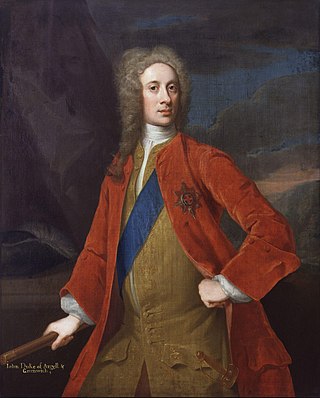
Field Marshal John Campbell, 2nd Duke of Argyll, 1st Duke of Greenwich,, styled Lord Lorne from 1680 to 1703, was a Scottish nobleman and senior commander in the British Army. He served on the continent in the Nine Years' War and fought at the Battle of Kaiserwerth during the War of the Spanish Succession. He went on to serve as a brigade commander during the later battles of the War of the Spanish Succession. Next he was given command of all British forces in Spain at the instigation of the Harley Ministry; after conducting a successful evacuation of the troops from Spain, he became Commander-in-Chief, Scotland. During the Jacobite Rebellion, he led the government army against the Jacobites led by the Earl of Mar at the Battle of Sheriffmuir. He went on to serve as Lord Steward and then Master-General of the Ordnance under the Walpole–Townshend Ministry.

Field Marshal Sir Robert Rich, 4th Baronet was a British cavalry officer. As a junior officer he fought at the Battle of Schellenberg and at the Battle of Blenheim during the War of the Spanish Succession. He was then asked to raise a regiment to combat the threat from the Jacobite rising of 1715. He also served with the Pragmatic Army under the Earl of Stair at the Battle of Dettingen during the War of the Austrian Succession. As a Member of Parliament he represented three different constituencies but never attained political office.

Field Marshal James O'Hara, 2nd Baron Tyrawley and 1st Baron Kilmaine, PC, was an Irish officer in the British Army. After serving as a junior officer in Spain and the Low Countries during the War of the Spanish Succession, he went on to become British ambassador to Lisbon establishing a close relationship with King John V there. He undertook a tour as British ambassador to Saint Petersburg before becoming Governor of Gibraltar where he set about improving the fortifications. He was briefly commander of British troops in Portugal during the Seven Years' War but was replaced within a few months. During his military career, he was colonel of eight different regiments.

Field Marshal Sir George Howard KB, PC was a British military officer and politician. After commanding the 3rd Regiment of Foot at the Battle of Fontenoy in May 1745 during the War of the Austrian Succession and after commanding that regiment again at the Battle of Falkirk Muir and the Battle of Culloden during the Jacobite Rebellion, he returned to the continent and fought at the Battle of Lauffeld. He went on to command a brigade at the Battle of Warburg during the Seven Years' War. He subsequently became the Governor of Minorca.
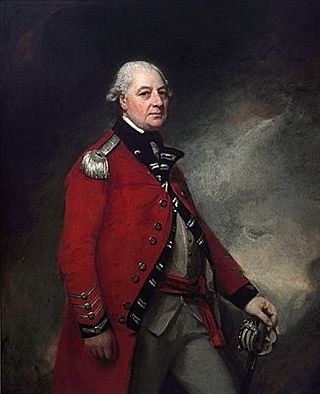
Field Marshal George Townshend, 1st Marquess Townshend, PC, known as The Viscount Townshend from 1764 to 1787, was a British soldier and politician. After serving at the Battle of Dettingen during the War of the Austrian Succession and the Battle of Culloden during the Jacobite Rising, Townshend took command of the British forces for the closing stages of the Battle of the Plains of Abraham during the Seven Years' War. He went on to be Lord Lieutenant of Ireland or Viceroy where he introduced measures aimed at increasing the size of Irish regiments, reducing corruption in Ireland and improving the Irish economy. In cooperation with Prime Minister North in London, he solidified governmental control over Ireland. He also served as Master-General of the Ordnance, first in the North Ministry and then in the Fox–North Coalition.

The 32nd Regiment of Foot was an infantry regiment of the British Army, raised in 1702. Under the Childers Reforms it amalgamated with the 46th Regiment of Foot to form the Duke of Cornwall's Light Infantry in 1881.

Sir George Nugent, 1st Baronet, GCB was a British Army officer. After serving as a junior officer in the American Revolutionary War, he fought with the Coldstream Guards under the Duke of York during the Flanders Campaign. He then commanded the Buckinghamshire Volunteers in the actions of St. Andria and Thuyl on the river Waal and participated in the disastrous retreat from the Rhine. He went on to be commander of the northern district of Ireland, in which post he played an important part in placating the people of Belfast during the Irish Rebellion, and then became Adjutant-General in Ireland. He went on to be Governor of Jamaica, commander of the Western District in England, commander of the Kent District in England and finally Commander-in-Chief, India.

The 30th (Cambridgeshire) Regiment of Foot was an infantry regiment of the British Army, raised in 1702. Under the Childers Reforms it amalgamated with the 59th Regiment of Foot to form the East Lancashire Regiment in 1881.

John Parr was a British military officer and governor of Nova Scotia. He is buried in the crypt of St. Paul's Church (Halifax).
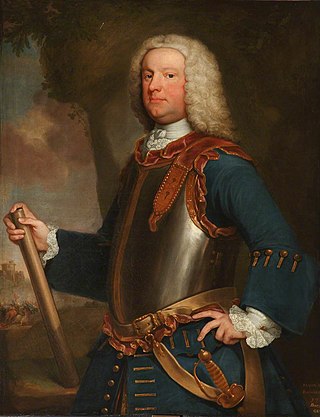
Lieutenant-General Richard Onslow was a British Army officer and politician. After the death of their parents, his older brother Arthur bought him a captain's commission in the British Army. He first saw action in the Anglo-Spanish War in 1727, after which he was returned to Parliament for the family borough of Guildford. His political contributions were negligible in comparison to his brother, and he continued to serve as a career officer, holding commands in the War of the Austrian Succession at Dettingen and Fontenoy. In 1759, he was appointed Governor of Plymouth and commander of the Western District, and died as a lieutenant-general the following year while presiding over two prominent courts-martial.

Lieutenant General William Home, 8th Earl of Home was a Scottish peer and the British Governor of Gibraltar between 1757 and 1761. Lord Home was a well-known spendthrift.

General Joseph Sabine was a British Army officer who fought in the Nine Years' War, the War of Spanish Succession and the Jacobite rising of 1715. He was later a politician who sat in the House of Commons from 1727 to 1734, becoming Governor of Gibraltar in 1730.

General Henry Edward Fox was a British Army general who served brief spells as Governor of Minorca and Governor of Gibraltar.
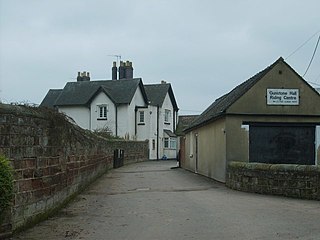
Lieutenant General Thomas Fowke, also spelt Foulks, circa 1690 to 29 March 1765, was a British military officer from South Staffordshire, who was Governor of Gibraltar from 1753 to 1756, and twice court-martialled during his service. The first followed defeat at Prestonpans in the 1745 Jacobite Rising, when he was acquitted. As Governor, he was tried again for his part in the 1756 Battle of Minorca, a defeat that led to the execution of Admiral Byng.

Lieutenant General Humphrey Bland was an Irish professional soldier, whose career in the British Army began in 1704 during the War of the Spanish Succession and ended in 1756.
Brigadier General Thomas Stanwix was a British Army officer and politician who sat in the House of Commons from 1702 to 1725. He served as Governor of Gibraltar.
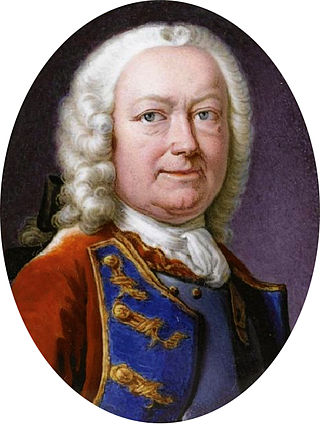
Lieutenant General William Hargrave was a British Army officer and Governor of Gibraltar.
General Sir William Houston, 1st BaronetKC was a British Army officer and Governor of Gibraltar. Houston joined the army in 1781, and by the start of the French Revolutionary War was a captain. He fought in the Flanders campaign before being promoted to major in 1794. As a lieutenant-colonel he fought at the Capture of Minorca and at the sieges of Alexandria and Cairo. Promoted to colonel in 1802, Houston fought in the Walcheren Expedition of 1809 before being promoted to major-general.
Lieutenant-General Sir James Frederick Lyon was a distinguished officer of the British Army who served as Governor of Barbados from 1829 to 1833.
Lieutenant-General John Folliot or Folliott was an officer of the British Army.

















